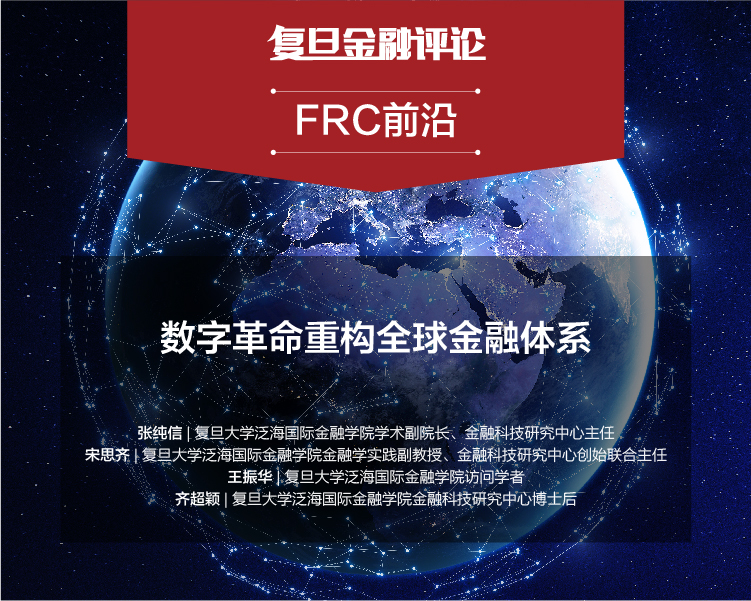数字革命重构全球金融体系

导语
价值的数字化代表着下一场数字革命,这场革命将释放前所未有的可替代性和流动性,给数字金融和商业模式创新带来根本性的颠覆。

拉至底部,阅读英文原文
在全球继续抗击新冠肺炎大流行的时候,创新在维持商业发展、寻找长期解决方案的进程中发挥了引领作用。当我们逐渐从这场危机中复苏,这些解决方案将刺激经济增长。随着线上工作以前所未有的规模展开,Zoom、微信、淘宝等在线服务提供商维持着全球团结一致、相对常态化的氛围。与此同时,我们正在探索新一代数字解决方案,以帮助应对公共卫生危机的经济影响,这标志着世界经济和金融体系发展迈入一个变革性的新阶段。
DCEP试点:撬动经济复苏的杠杆
2020年3月24日,中国人民银行宣布已完成央行数字货币和电子支付平台(DCEP)基本功能的开发,相关法律已在起草。已经公布的测试地点为深圳、成都、苏州和雄安新区,初步计划似乎是围绕诸如交通等政府消费支出展开。
与支付宝和其他依赖基础设施的系统不同,采取匿名制的DCEP系统允许数字钱包在没有联网银行账户甚至没有互联网连接的情况下运行,从而实现真正的类现金使用体验。如此一来,消费者和供应商都能以一种全新的、非中介的方式进行商业活动,并享有一个由主权背书的主权交易单位的监管、可靠性和高效性。这一切对资金转移、国际贸易和结算以及人民币持续国际化的潜在影响,再强调也不为过。
然而,在新冠肺炎疫情危机期间,数字技术的影响力可能更大。当美国举步维艰地开展“薪酬保护计划”(PPP),最需要资金的小企业只能获得有限的资金,而像洛杉矶湖人队这样的大企业却获得了数百万美元的资金。数字货币将允许政府追踪补助的分配和使用。此外,由于大量的应用程序以非分布式的方式处理,导致处理过程和信息并不透明,部署也很薄弱(第一批3500亿美元的应用程序在有效部署了约30%的资金后就停止了运行),“薪酬保护计划”已经不堪重负。而一个基于区块链的系统能够真正确认需求,近乎即时执行部署,并保证投入的资金能够解决上述许多问题。
也许更重要的是,有资金需求的公民依然在疫情危机中苦苦挣扎、急需解围。智能合约技术和国家数字货币系统确保了直接面向用户的资金刺激,消除了传统金融系统逐层渗透产生的损失。专家预测,最终的经济复苏很可能以波浪式递进,行进轨迹有起有落而不是V形,因此经过多轮此类注资后,数字货币系统的效率将呈现几何式增长。随着疫情在世界不同地区以疾病扩散和传染的形式出现,全球经济紧密相连,经济复苏既受国内环境影响,也受国际环境影响,因而可能需要多个阶段的经济刺激。在过去20年,全球市场产生了186万亿美元的现金供应,却只创造了46万亿美元的持续GDP。显然,盲目地向经济注入大量资金并不是解决之道。我们必须把目标对准最需要资本的地方,确保最脆弱群体至关重要的消费。
价值的数字化:数字经济迎来后浪
最初的互联网革命使信息数字化成为可能,使准入门槛平民化,使每个人都能通过网络获得信息。价值的数字化代表着下一场数字革命,这场革命将从根本上改变世界经济,由此催生的机会远不止传统货币和在线支付的新数字形态。从房地产、艺术品到大宗商品等任何有价值的东西中创造数字资产的能力,将释放前所未有的可替代性和流动性。这也将给数字金融和商业模式创新带来根本性的颠覆,使整个金融生态系统能够有效地创建定制的激励结构,以优化其自身的数字经济。
2019年8月,全球首批受监管的数字资产银行Seba银行和Sygnum均获得瑞士金融市场监管局(FINMA)颁发的首批银行和证券交易商牌照。同年10月,Sygnum还在新加坡获得了资本市场服务许可证,允许它提供数字资产管理服务。由于全球监管的明确性,从纽约到新加坡,完全受监管的数字资产证券的新形式,即证券化通证发行(STOs)正在全球各地涌现。尽管瑞士和新加坡在受监管的数字资产领域率先占据领导地位,但下一个值得关注的将是中国。
2019年10月15日,中国发布了区块链服务网络(BSN),这是一个跨公共网络、跨区域、跨机构的国家区块链服务基础设施平台。该平台由提供顶层规划的国家信息中心牵头,由中国银联和中国移动联合区块链技术及其现有网络资源自主开发部署。BSN于2020年4月15日完成了内部测试,计划在中国大陆建成大规模互通网络的中心核心基础设施技术,涵盖城市、政府、公司和个人。该网络还将成为数字丝绸之路的骨干,为中国遍布全球的所有贸易伙伴提供互联互通。BSN将是一种全新的互联网协议,使数据、价值和数字资产以一种完全透明和可信的方式,在任何想成为网络节点的个体之间以一种更有效的方式共享数据。
REITs对比房地产通证:求同存异
房地产是世界上最大的资产类别,全球估计总资产价值超过250万亿美元,超过股票和债券的总和。然而,据估计每年只有不到3%的投资优质房地产被交易,相比之下价值股和债券的交易量分别接近100%和60%。房地产投资市场的流动性不足,主要是由于这些资产的资金需求大、投资周期长。房地产投资信托基金(REITs)于20世纪60年代创立,旨在为房地产市场提供流动性,本质上是房地产资产的共同基金。目前,REITs的全球市值约为7万亿美元,以某些指标衡量,过去30年REITs的市场表现几乎优于所有其他资产类别。
中国已经涉足私人交易的“准房地产投资信托基金”(“准REITs”),并寻求在不久的将来参与REITs领域的竞争。这些证券的价值同样来自房地产,但它们是支付利息的债务工具,而不是支付股息的股权REITs,后者是全球REITs的共同结构。2020年4月30日,中国宣布为REITs创建一个公开市场的计划。根据国家发改委和证监会联合发布的《关于推进基础设施领域不动产投资信托基金(REITs)试点相关工作的通知》,将“按照市场化、法治化原则,充分依托资本市场,积极支持符合国家政策导向的重点区域、重点行业的优质基础设施项目开展REITs试点”。
然而,房地产投资信托基金并非没有缺点。首先,由于本质上类似于积极管理型基金,它们会产生交易成本和费用。这些成本和费用的产生既为公司创利,也覆盖了管理、营销和其他费用的开支。同理,这些投资组合的规格可能非常严苛,有几个级别和等级的资产,使得外行投资者难以理解。其次,大多数REITs还承担着重要的杠杆作用,通常占总资产的三分之一至一半不等。如今房地产证券型通证发行(real estate STOs)已开发出针对上述问题的解决方案,极大地降低了成本并提高了交易效率,同时提升了安全性、准确性、透明度、监控和可跟踪性。房地产证券型通证既可以像债务一样支付利息,也可以具有股权属性,将价值与基础资产联系起来。
长久以来,复旦大学泛海国际金融学院金融科技研究中心与美国公司Securitize联手合作,为代币发行者提供成功发行数字证券的解决方案。在与发行者的访谈中,我们发现证券型通证发行(STOs)通过智能合同为企业提供治理方案,可以从一个接入点吸引多个投资者,为遍及14个司法管辖区的数十甚至数百位投资者提供服务。它们的系统支持全透明的跨境交易,发行的代币可以在全球任何时间进行交易,不受传统交易所营业时间的限制。
STOs通常以单一资产为基础,完全透明,几乎没有管理费或交易费,而且没有杠杆。与之相反,REITs提供资产管理服务和多样化。我们并不认为房地产STOs一定会替代REITs,同时也不难想象,最终类似REITs的投资组合也可能持有房地产代币。从短期来看,这两种市场都存在。
区块链服务网络服务中国政务
政府部门为加强自身治理能力、提升治理效能,纷纷采用区块链技术,形成了政务区块链。长期以来,我国政府一直致力于摆脱“信息孤岛”、突破数据壁垒、提高为民办事的效率。而区块链技术的可追溯、不可篡改、数据加密等特性可以解决当前的一些痛点。
2017年是中国政务区块链应用元年。到2019年,新增项目从2017年的2项增长至23项。目前,已有多个省和城市引入了政务区块链应用,比如北京、上海、天津等。深圳更率先推出了区块链发票和央行区块链交易平台。然而从具体数量上来看,中国政务区块链的应用仍然较少,主要集中在北京和广东省,两者总和超过全国总数的三分之一。目前较为成熟的政务区块链应用主要有:司法存证、电子发票和黄金交易平台。而近期,备受期待的央行数字货币推出。
中国区块链服务网络(BSN)于2020年4月在全球启动,是中国首个全球基础设施网络。中国国家信息中心副主任张学颖指出,区块链服务网络将为我国智慧社会建设和数字经济发展提供高质量、定制化的技术服务平台支撑和可信、可靠、可扩展的基础设施服务载体。经国家疾控中心的部署,它已经在新冠肺炎疫情的防控中发挥积极作用。
The Digital Revolution Reshapes the Global Financial System
Charles Chang
Deputy Dean of Academics, Professor of Finance and Director of the Fintech Research Center at Fanhai International School of Finance, Fudan University
Michael Sung
Associate Professor of Practice in Finance at Fanhai International School of Finance and the co-director of the Fintech Research Center at Fanhai International School of Finance, Fudan University
Richard Wang
Visiting Scholar at Fanhai International School of Finance, Fudan University
Chaoying Qi
Post-doctor of the Fintech Research Center at Fanhai International School of Finance, Fudan University
While the world continues to fight the global COVID-19 Pandemic, innovation has led the way in maintaining commerce and finding long-term solutions that will fuel economic growth once we emerge from this crisis. Work is being conducted online in unprecedented numbers and online service providers like Zoom, WeChat, Taobao, and others have led the way in helping the world maintain a sense of togetherness and relative normalcy. Meanwhile, next generation digital solutions are being explored that will help us to combat the economic repercussions of the health crisis and that represent a transformative stage in the development of world economies and financial systems.
DCEP Testing and Economic Recovery
On March 24, the People’s Bank of China announced that it had completed the development of the basic functions of the central bank’s digital currency electronic payment (DCEP) and is drafting laws for its implementation. Test sites have been announced in Shenzhen, Chengdu, Suzhou, and the Xiong'an New District with early plans seeming to surround government-run consumption such as transportation.
Unlike Alipay and other infrastructure-dependent systems, the pseudonymous system DCEP allows for digital wallets to function in the absence of linked bank accounts and even Internet connections, allowing for a truly cash-like experience. This will empower consumers and vendors alike to conduct commerce in a whole new, un-intermediated way, while enjoying the regulation, reliability, and efficiency of a digital sovereign-banked unit of trade. The potential impact on money transfer, international commerce and settlement, and the continued internationalization of the RMB cannot be over-stated.
However, during the COVID Crisis, the impact of this technology may be still larger. As the US struggles with its Payroll Protection Program (PPP), small businesses that need the money the most have limited access while large corporations like the Los Angeles Lakers have received millions in funding. A digital currency would allow governments to track both the distribution and use of subsidies. Furthermore, the PPP has been overrun by a massive number of applications being processed in a non-distributed way where both process and information remain largely opaque and deployment has been weak (with the first 350 billion halted after only about 30% of its capital was effectively deployed). A Blockchain-based system of true validation of need, nearly immediate deployment, and assurances as to use of capital would resolve many of these issues.
Perhaps more importantly, citizens in need likewise continue to struggle. Smart contract technology along with a national digital currency system ensure direct-to-user stimulus, eliminating losses incurred while trickling through traditional financial systems. Such a system would be exponentially more effective in the face of multiple such infusions, as experts predict that the eventually economic recovery is likely to come in waves, with ups and downs, rather than in a V-shape. The disease has already shown itself to have progressed in waves of disease expansion and contagion in different regions of the world, and as the global economy is clearly linked, economic recovery will be impacted by both the domestic and international environment. Multiple stages of economic stimulus may be required. Over the last 20 years, the world has generated 186 trillion dollars in cash supply that has generated only 46 trillion in sustained GDP. Clearly, blindly flooding the economy with cash is not the answer. We must aim to target capital where it is most needed and ensure critical consumption for the most vulnerable.
Digitization of Value
The original Internet revolution allowed for the digitization of information, democratizing its access for everyone in the world by making it available online. The digitization of value represents the next digital revolution that is on the cusp of fundamentally transforming the world’s economies. The opportunity is much larger than just new digital forms of traditional currencies and online payment options. The ability to create a digital asset out of anything of value, from real estate to works of fine art to commodities, will provide unprecedented fungibility and liquidity. This will enable radically disruptive digital financing and business model innovation that can allow ecosystems to effectively create customized incentive structures to optimize their own digital economy.
In August 2019, the world's first regulated digital asset banks Seba and Sygnum both received the first banking and securities dealers’ licenses from Switzerland’s Financial Market Supervisory Authority (FINMA). Later in October that year, Sygnum also received a capital markets services license in Singapore, allowing it to provide digital asset management services. As a result of the regulatory clarity around the world, new forms of fully regulated asset-backed digital asset securities, known as securitized token offerings (STOs), are popping up globally, from NYC to Singapore. While both Switzerland and Singapore take the initial lead in the world of regulated digital assets, the country to watch will be China.
On October 15, 2019, China announced the Blockchain Service Network (BSN), which is a cross-public network, cross-regional, and cross-institutional national Blockchain service infrastructure platform. This platform is spearheaded by the National Information Center which provides top-level planning and is independently developed and deployed by China UnionPay and China Mobile, combining Blockchain technology and with their existing network resources. BSN completed internal testing on April 15th and will be the backbone infrastructure technology for massive interconnectivity throughout Chinese mainland, from city governments, to companies and individuals alike. The network will also form the backbone to the Digital Silk Road to provide interconnectivity to all of China's trade partners around the globe. The BSN will be a new Internet protocol to allow a more efficient way to share data, value, and digital assets in a completely transparent and trusted way between anyone who wants to be a node on the network.
REITS vs Real Estate Tokens
Real estate is the world’s largest asset class with a total estimated asset value of over US$250 trillion globally, larger than stocks and bonds combined. However, it is estimated that less than 3% of investment quality real estate is traded each year, compared with nearly 100% of the value stocks and 60% of bonds. This illiquidity in the real estate investment market is attributed to the large capital requirement and long investment period associated with these assets. Real Estate Investment Trusts (REITs) were developed in the 1960s to provide liquidity to this market and are essentially mutual funds for real estate assets. The current global market cap for REITs is around US$7 trillion, and by some measures, REITs have outperformed almost every other asset class over the past 30 years.
China is looking to join this fray in the near future, having already dabbled in privately-traded “Quasi REITs.” These securities likewise derive their value from real estate but are debt-instruments that pay interest, rather than equity REITs that pay a dividend, the common structure for REITS globally. On April 30, China announced plans to create a public market for REITS. According to a statement jointly issued by the National Development and Reform Commission (NDRC) and the China Securities Regulatory Commission (CSRC), the “Notice Concerning Work in Relation to Advancing Infrastructure Real Estate Investment Trust Trials,” CSRC and NDRC will “make full use of capital markets to actively support the undertaking of REIT trials for high-quality infrastructure in key areas and industries in accordance with the principles of the market and rule of law.”
REITs, though, are not without their shortcomings. First, because of they are essentially structured like actively managed funds, they generate transactions costs and fees that arise both for the profit of the firm and to cover the overhead of managing, marketing, and other expenses. Likewise, these portfolios can be draconian and have several levels and grades of assets that may be difficult for lay investors to understand. Most REITS also take on significant leverage, often ranging from a third to a half of total assets. Real estate STOs have developed to generate solutions to some of these concerns, greatly reducing costs and increasing transaction efficiency, all while improving security, accuracy, transparency, monitoring, and traceability. Real estate STOs may be either debt-like in paying interest or have equity qualities linking value to the underlying assets.
The Fintech Research Center has been working with Securitize, a US-based company that provides solutions for token issuers to successfully offer their digital securities. In interviews conducted with issuers, we find that STOs provide governance solutions through smart contracts, engage multiple investors from one access point, and can serve dozens if not hundreds of investors in 14 jurisdictions. Their system supports fully transparent cross-border transactions, and tokens can be traded at any time around the world without the limitations of operating hours of a traditional exchange.
STOs are often written on single-assets and are fully transparent, have virtually no management or trading fees, and are unlevered. REITs, in contrast, provide asset management services and diversification. We don’t view real estate STOs necessarily as a substitute for REITs, and it’s not hard to imagine eventual REIT-like portfolios that might also hold real estate tokens. In the short-term there certainly appears to be a market for both.
Administrative Affairs Blockchain and Blockchain Service Network (BSN) in China
In order to strengthen their governance capabilities and improve governance efficiency, government departments are adopting Blockchain technology, forming an administrative affairs Blockchain. For a long time, the Chinese government has aimed to move away from "information islands," to break through data barriers, and to improve the efficiency of civil affairs. With traceability, immutability, and data encryption as its features, Blockchains can be a solution to some current pain points.
China’s administrative affairs Blockchain applications first appeared in 2017. By 2019, the number of new projects had increased from 2 to 23. Currently, several provinces and cities like Beijing, Shanghai, and Tianjin have introduced administrative affairs Blockchain applications. Shenzhen was first to launch Blockchain invoices and a central bank Blockchain trading platform. However, in terms of specific numbers, the amount of administrative affairs Blockchain applications in China is still small, and it is dominated by Beijing and the Guangdong Province, the sum of the two exceeding one third of the total number nationwide. At present, the most mature applications are judicial deposit certificate, electronic invoice, and gold trades, but recently, the highly anticipated DCEP was launched.
Launched globally this past month, the BSN is China’s first global infrastructure network, and Zhang from the National Information Center points out that BSN will provide a high-quality and customized technical service platform and a credible, reliable, and scalable infrastructure service provider for China's smart infrastructure and for the development of the digital economy. It has even begun to play an active role in the control of the COVID-19 pandemic as it has been deployed in the national center for disease control.
*本文经原作者授权,仅代表作者个人观点。